 Okay, I’m way overdue on finishing “Reloading the .257 WM…in excruciating detail Part III”. I do have a prepared statement to read in my defense – “I did complete Part II but, by the time I got to Part III, I fell asleep at the keyboard”. The .257 Weatherby is a great cartridge, the little Ultra Lightweight Weatherby is a great piece of work and it will be used frequently. I just wasn’t learning anything new with the handloading exercise, and writing more on this topic was like writing about the growth of algae. In any event, I did publish the handloads on the home page and I am a big fan of the rifle.
Okay, I’m way overdue on finishing “Reloading the .257 WM…in excruciating detail Part III”. I do have a prepared statement to read in my defense – “I did complete Part II but, by the time I got to Part III, I fell asleep at the keyboard”. The .257 Weatherby is a great cartridge, the little Ultra Lightweight Weatherby is a great piece of work and it will be used frequently. I just wasn’t learning anything new with the handloading exercise, and writing more on this topic was like writing about the growth of algae. In any event, I did publish the handloads on the home page and I am a big fan of the rifle.
At the moment I am interested in working with my Marlin Guide Gun. It’s stubby, throws lead the size of a baseball, barks loudly, and produces some really neat muzzle blast. What more could anyone want in a firearm. I needed a break from slick technology, or at least the appearance of slick technology. In reality, with the exception of a stock actually made from a tree, the Marlin is almost as advanced in its technology as the Weatherby.
The Marlin has a strong action. Modern Springfield trap door design rifles top out at 25,000 c.u.p, about the safe limit for modern low pressure smokeless loads for this cartridge. The Marlin can handle 40,000 c.u.p., not much less than the 50,000 c.u.p. limit for this cartridge for the super duty Ruger No.1 action. The thinking on this issue is not consistent; Hornady assesses the situation as described. Vihtavuori lumps the Marlin in with the old trapdoor Springfield, which should be amusing to people who shoot modern .45-70 factory ammo and the .450 Marlin on a regular basis. Speer must have asked Al Gore to write their opinion, while they applaud the strength of modern Marlin lever action rifles, they feel they are not quite as strong as Hornady represents.
The .45-70 load performance at the 40,000 c.u.p. level is truly spectacular. I’ve had the gun for awhile, had time to put a few boxes of factory ammo through it, at least enough ammo to know I really like the gun and cartridge. With all of the disparity in handload performance reporting and varying opinions expressed in handloading manuals, I thought there was a lot for me to learn with this experience and a chance to handload what looks and acts like a really big handgun cartridge.
Finally, a home for the scope from Premier Reticle
A short time ago, I purchased a Leupold scope from Premier Reticle; a simple and inexpensive 2-7x33mm Vari-X II, with a custom fitted fine duplex reticle fitted in place of the heavy duplex factory standard. I had the Guide Gun and a .416 Weatherby I intended to work with, and I wanted to select a scope that would work well on both. I thought this would be a good time to move forward with the Marlin. If you are interested in the details of the scope, the article is in the Real Guns archive.
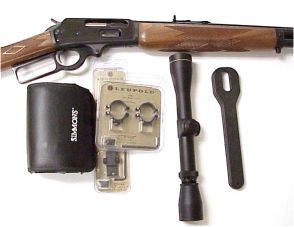 I’m actually getting this scope mounting business down to a quick job, maybe ten minutes start to finish.
I’m actually getting this scope mounting business down to a quick job, maybe ten minutes start to finish.
There are a few items necessary to knock this job out: a gun, preferably the one you wish to mount the scope on, scope, an over priced plastic ring tool from Leupold, a one piece Leupold mount, a couple of rings to hang on the mount, and a boresighter. Yes, you do need proper screw drivers, and a Torx driver for mounts and rings, but I forgot to take a picture of them.
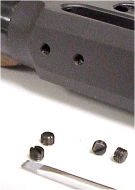 For the sake of killing time and space, let me offer some comments on tools and hardware. Use the right size screw drivers; tight fit in the slot, goes to the bottom and no overhang beyond the screw head diameter. A sloppy fit almost always ends up with gouged screw holes, chewed up screw heads or bare metal scratches as the driver tip slips out of the screw slot, and skids across the mirror smooth surface of the receiver. And you will never forget a scratch, even if it isn’t in plain site, even when….
For the sake of killing time and space, let me offer some comments on tools and hardware. Use the right size screw drivers; tight fit in the slot, goes to the bottom and no overhang beyond the screw head diameter. A sloppy fit almost always ends up with gouged screw holes, chewed up screw heads or bare metal scratches as the driver tip slips out of the screw slot, and skids across the mirror smooth surface of the receiver. And you will never forget a scratch, even if it isn’t in plain site, even when….
A scope ring wrench is about $9. With it, you can crank in dovetail mounts without distorting a ring or scratching the surface finish. A boresighter is priceless when mounting a scope and, judging from the prices, some manufacturers of these products feel the same way. You can preset your scope at home, get to the range and almost always be within a couple of inches or proper point of impact with initial rounds fired. Why waste boxes of ammo just trying to find the paper ?
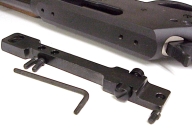 One piece Leupold mounts – I know there are nicer pieces, but none are more sturdy. I use a one piece base of this type on a couple of very heavy recoiling rifles I routinely shoot, and I’ve never had this type of mount work loose. This piece is secured to the Marlin’s solid receiver top with Torx fasteners. Leupold mounts and rings are packaged with a small Torx wrench – don’t toss it for a bigger wrench. The idea is, you crank down on the wrench for all you’re worth, and the small amount of leverage generated by the wrench will prevent you from stripping fasteners or receiver/ring threads.
One piece Leupold mounts – I know there are nicer pieces, but none are more sturdy. I use a one piece base of this type on a couple of very heavy recoiling rifles I routinely shoot, and I’ve never had this type of mount work loose. This piece is secured to the Marlin’s solid receiver top with Torx fasteners. Leupold mounts and rings are packaged with a small Torx wrench – don’t toss it for a bigger wrench. The idea is, you crank down on the wrench for all you’re worth, and the small amount of leverage generated by the wrench will prevent you from stripping fasteners or receiver/ring threads.
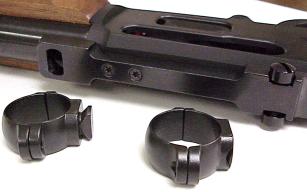 The mount installs nice and flush against the receiver and extends, to a small degree, over the barrel. It is secured with three Torx fasteners. The front mount is machined with a normal dovetail slot that firmly secures the front ring. The rear ring is notched and secured by the two “windage” screws at the rear of the mount.
The mount installs nice and flush against the receiver and extends, to a small degree, over the barrel. It is secured with three Torx fasteners. The front mount is machined with a normal dovetail slot that firmly secures the front ring. The rear ring is notched and secured by the two “windage” screws at the rear of the mount.
This is one of those features you have to just trust and not think about too much; the front of the scope is anchored and moving the mount adjustments would have to flex the scope tube to make any adjustment. Somehow, bending the scope just doesn’t seem like a good approach to adjustment. I try to make sure the front mount is centered and perpendicular to the bore before making minute rear mount adjustments. If I bore sight and see a large adjustment will be necessary, I pull the scope and adjust the front ring to get closer in preliminary alignment.
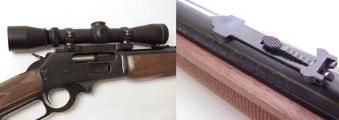 Marlin has made some nice design progressions in their sights. Gone is the old gold bead front sight that was present on my old .30/30 336, as is the simple rear sight that required Kentucky windage adjustment in the field, or a handy hammer and drift.
Marlin has made some nice design progressions in their sights. Gone is the old gold bead front sight that was present on my old .30/30 336, as is the simple rear sight that required Kentucky windage adjustment in the field, or a handy hammer and drift.
To prevent the rear sight from taking a set when the scope is in place but not in use, it’s best to slide the adjustor all the way forward to take the tension off the sight. The scope mounts very low and close to the axis of the bore, which is a good thing, but it hits the sight leaf. Fortunately, in addition to windage adjustment, the new model rear sight folds forward. In this position, the sight will clear the scope objective bell, even when mounted in low scope rings. The hammer clears the ocular with ease, and there is an offset hammer spur packaged with every Marlin carbine for anyone who has a problem getting under the scope when reaching for the hammer.
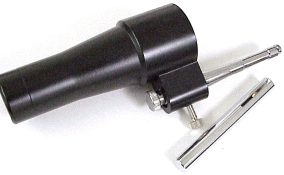 I wanted to cover a couple of points on boresight equipment. This is my personal Simmons unit. It looks very nice, works fine, but has a couple of serious problems. First of all, it’s as big and heavy as a……..well, a really big boresighter. No matter how well it’s secured in the bore, if you move around and tip the barrel left or right, the boresighter will rotate in the bore.
I wanted to cover a couple of points on boresight equipment. This is my personal Simmons unit. It looks very nice, works fine, but has a couple of serious problems. First of all, it’s as big and heavy as a……..well, a really big boresighter. No matter how well it’s secured in the bore, if you move around and tip the barrel left or right, the boresighter will rotate in the bore.
The lower spud, the rod that fixes the bore sighter in the bore, is made one per caliber, rather than the one I have in place in the picture which is an adjustable collet type. The fixed spud, by design, is relatively loose in the bore and relies on a phosphor bronze insert spring to hold it in place. In use, the spud droops and wobbles, and is hard to center when the insert follows the track of the grooves in the rifling. I have several ranges of adjustable spuds that fit tight in a range of perhaps .020″. All were designed by marketing and sales people, not tooling design people. There is no soft material like brass or Teflon coated parts to protect the bore, instead there are chrome hardened surfaces that could peen rifling or score a bore.
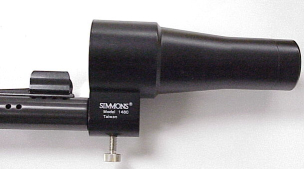 If you’re shopping for a boresighter, you may want to take a look at the spuds, they have more to do with the quality of the unit than the actual optics.
If you’re shopping for a boresighter, you may want to take a look at the spuds, they have more to do with the quality of the unit than the actual optics.
I don’t use leveling devices mounted to my scope to insure horizontal alignment, but this is a critical area. If the horizontal cross hair isn’t perpendicular to the scope base, scope adjustments will result in diagonal shifting of the bullet path. Since the human eye and brain connection works so well in detecting alignments when flying, motorcycle riding and using metallic sights, I thought the same combination should be good enough for proper scope installation. When you look through a scope and into a boresighter, you see the tool’s grid on a transparent background, with the cross hairs of the scope in overlay. You then adjust your scope until the scope’s cross hairs overlay the cross lines at the center of the boresighter grid.
A scope typically leaves the factory with the elevation and windage adjusters in a neutral, or mid adjustment position. If you need to move too far from this point to center on the boresighter, it’s probably a good idea to recheck the mount system mechanical parts alignment and get closer to center with the boresighter. Adjustment to moderately priced scopes are not exactly linear across the full range, so 1/4″ click in the middle may be a 1″ click at the outside of the range. In addition, a scope has a finite adjustment range, and you wouldn’t want to have 30″ of adjustment to the right and only 2″ to the left. In general it is best to see if the scope can be installed at mid range with maximum adjustment available in all directions.
The scope installation went fine, including adjustment for eye relief. I have no neck, and I typically need to use reversible mounts to get the scope back far enough for proper placement. In this case, I just pulled the scope back until the objective bell hot the front ring and everything fell into place.
Part II – Next
I have a good selection of bullets for the .45 bore and a good selection of powder. My objective is to see if I can get some of this new generation .45-70 high performance without unintentionally turning the Marlin into a custom take down model.
More “The Model 1895G”:
The Model 1895G Part I
The Model 1895G Part II
The Model 1895G Part III
The Marlin 1895G – reducing felt recoil
Handload Data 45-70 Gov’t
Thanks,
Joe

Email Notification